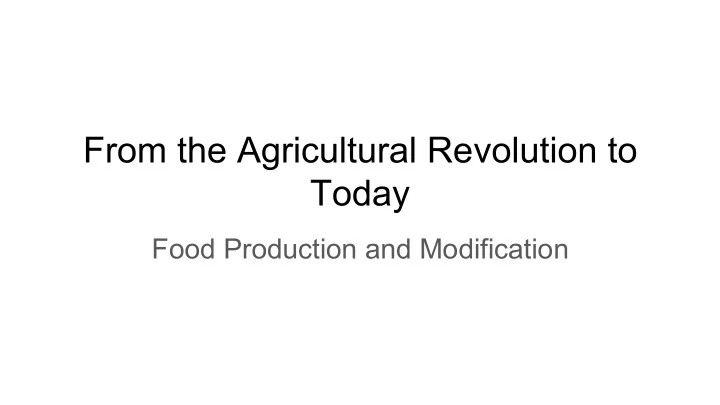

From the Agricultural Revolution to Today Food Production and Modification
Plants and water Domestication took hundreds if not thousands of years Different in different parts, trial and error, noticed that some grains had certain characteristics, replant them according to size, taste, etc. Grains easier to store than other plants Calories were important Had to find ways to get water to plants Irrigation developed
Surplus of food Once surplus of food is created- Stone tools to help procure the grain from the chaff Population centers grew, needed to follow calendar, animals become more important to transportation and cultivation Cooperation is essential, need laws and government Need to protect farmers from loss
Code of Hammurabi [48] If any one owe a debt for a loan, and a storm prostrates the grain, or the harvest fail, or the grain does not grow for lack of water; in that year he need not give his creditor any grain, he washes his debt-tablet in water and pays no rent for this year.
Surplus of food Diversification of labor Artisans Priestly class Rulers Laborers
More modification Chinese found a rice that grows twice a year Need to supply the North with Southern rice Build Grand Canal
More modification Maize, corn to us, was one of the more “modified” foods in the ancient world Darwin would use the term “artificially selected”
Production improvements Use of oxen, cow, mules, horse- all came with technological innovation Horse shoes, ox collar, heavy plow More grains, quicker Private land becomes a thing- more governance necessary Barbed wire to mark who owns what
Up to current GMO The tension between government and science continues Breakthrough to modern GM comes in the 1973 Herbert Boyer and Stanley Cohen- targeted selected antibiotic resistance gene from one strain of bacteria to another Rudolf Jaenisch and Beatrice Mintz used same procedure and introduce a foreign DNA into a mouse embryo
The reaction was swift “Although this new technology opened up countless avenues of research possibilities, immediately after its development, the media, government officials, and scientists began to worry about the potential ramifications on human health and Earth’s ecosystems.” - From Corgis to Corn a Brief Look at the Long History of GMOs
Important Conference 1975- Asilomar Conference Agreement on Guidelines to continue GE research: Safety and containment procedures Lead researcher responsible for safety of workers Educate scientific community of important developments Guidelines to stay flexible to account for future findings Governments around the world agreed to continue GE research as a result
Post-Asilomar developments 1980- GE modifies bacteria to break down oil Supreme Court finding also gives ownership rights to companies 1982- GM bacteria allows for synthesized human insulin 1987- Calgene’s Flavr Savr tomato 1995- First pesticide producing crop
More post-Asilomar developments 1996- Bt corn 1996- Roundup ready crops- soybean, corn, sugar beets 2000- Golden Rice to combat vitamin A deficiencies No GE animals to date for human consumption 2009- Drug from GE animal, ATryn, to fight blood clotting disorder
Controversies Religious and philosophical debate Environmental and health Bt and butterflies- no conclusive evidence found Cotton and Indians- no conclusive evidence found More and more regulatory initiatives to label- US currently has no mandatory law Scientific community has largely concluded GM food poses no increased danger than regular crops
Source: Gabriel Rangel is a Ph.D. candidate- Biological Sciences in Public Health Program, Harvard. http://sitn.hms.harvard.edu/flash/2015/from-corgis-to-corn-a-brief-look-at-the-long- history-of-gmo-technology/ Some really interesting reading: http://sitn.hms.harvard.edu/flash/2015/how-to-make-a-gmo/ http://sitn.hms.harvard.edu/signal-to-noise-special-edition-gmos-and-our-food/
Recommend
More recommend